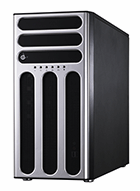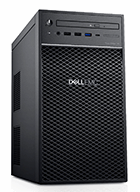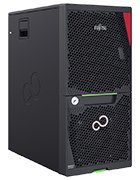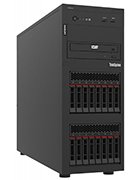How to purchase the best server hardware for small businesses
Before buying a server, it's important to assess an SMB's needs. Review these seven steps outlining the factors an organization should consider before purchasing a server.
Organizations of all sizes rely on servers to support their workloads, and small businesses are no exception. However, purchasing a server can be a daunting task as there are many factors to consider beyond just the server.
Here, we examine these considerations and present five servers from Asus, Dell, HPE, Fujitsu and Lenovo.
SMB server basics
The term server can refer to a physical computer or to a software program. Here, we're concerned only with the physical computer, which is made up of multiple hardware components capable of supporting business applications and their workloads.
A server shares resources and accommodates workflows across a network. Servers often interface with the internet and support on-site and remote users. The system typically runs 24/7 as it processes requests from multiple users and applications -- frequently at the same time. In some cases, a server might handle large files or amounts of data, depending on the workloads.
A server's hardware includes processors, memory modules, internal storage and network adapters for connecting to the corporate network and, sometimes, a storage or management network. In addition, a server usually includes components or features to ensure greater reliability and security, such as cryptographically signed firmware or error correction code (ECC) protection for bit errors on the memory chips. The exact configuration can vary significantly between servers and manufacturers, which is why it's important that SMBs proceed cautiously when selecting a server.
The pros and cons of an on-premises or cloud server
Does the organization need an on-premises server, or should it consider cloud computing? For many SMBs, the cloud can be a better alternative. A cloud server eliminates the need for an on-premises system and the environment that supports it. Cloud computing also reduces the dependency on internal IT resources and provides a flexible and scalable environment for changing workloads. In addition, cloud services offer built-in data protection that helps ensure data remains available, secure and cheaper than on-premises options.
In contrast, on-premises servers pose several challenges. First, the organization must have space to house the server and electricity to power and cool it. In addition, staff must continuously maintain the server, ensure its security, protect it from natural disasters and replace any failed hardware components. All these efforts take time and money -- not just the capital outlay, but also the ongoing maintenance expense.
For many SMBs, hosting server operations on a cloud server is ideal, but it isn't without its downsides. The organization must pay recurring monthly cloud fees and has no access to the server environment nor control over the underlying platform. The cloud provider determines when to upgrade the underlying systems and controls how long it takes to restore or repair those systems. With a cloud server, SMBs are also reliant on the internet for continuous connectivity.
With an on-premises server, the organization has complete control over the environment and the server itself. This is important for keeping critical data in-house or expediting upgrades or repairs. Although this investment comes with upfront costs, servers can be less expensive in the long term when compared to cloud subscription fees. Plus, if the organization deploys a server on premises to handle business-critical applications, it can still use cloud services for less sensitive operations, such as hosting the SMB's website.
An in-house server can support a wide range of workloads. This includes running an email management program or other business applications, hosting a database management system or web application, serving as a media or file server, and providing print services. SMBs can also use virtualization to host multiple applications on the server by running each app on its own virtual server. The key is to ensure that the server the SMB selects can handle the anticipated workloads, regardless of how it plans to implement them.
How to choose the right server
An SMB can buy a dedicated server outright, lease a complete system, assemble it or purchase a refurbished server.
The following seven steps outline many of the factors a SMB should consider before selecting a server.
1. Identify workload requirements
- List the types of applications and services you plan to run on the server and the requirements for operating each, including processor, memory and storage.
- Confirm the number of users per application and how they use the application.
- List the amount and type of data you want the server to process and store, including file sizes. Consider data at rest and in motion.
- Identify how the SMB implements each application -- bare metal, virtual server or container -- and include the hypervisor and container software in the planning.
- Calculate workload requirements for the near and distant future.
2. Calculate the server budget
- Get an estimate for the server, including additional features and optional service agreements. Consider long-range scaling and parts replacement. A less expensive server might be tempting, but it might not be powerful or reliable enough to handle mission-critical workloads.
- Estimate the IT resources it takes to install, configure, maintain and update the server. Include any costs for training personnel or hiring outside expertise to troubleshoot or maintain the server.
- Examine the cost to house, power and cool the server.
- Consider the costs associated with licensing the OS, security software, management software and any other software required to keep the server operational.
- Include expenses associated with protecting the data, the server and its physical environment against security breaches, natural disasters or other events that could lead to data being lost, corrupted or compromised.
3. Identify operational requirements
- Identify all security, privacy and compliance requirements as they apply to the server.
- Detail reliability and availability requirements as they apply to data delivery and ongoing server operations.
- Identify short- and long-term scalability requirements.
- Check network connectivity requirements, including management and storage networks.
- Calculate the total number of users who access the server, how often they access it, how long they connect to the server and any other work patterns that could affect server usage.
- Identify the environment in which the server operates, along with any limitations, such as power, cooling or noise concerns.
4. Choose the OS
- Examine the server OSes currently available, such as Microsoft Windows Server or RHEL.
- Determine which OS best meets the SMB's workload requirements. From this choice, select the best version and edition to meet those requirements.
- Identify the level of in-house expertise for working with a particular OS.
- Consider how much training it takes to get IT personnel up to speed with a particular OS or whether the SMB needs to bring in outside expertise.
- List the administrative tools the SMB currently uses and if they're specific to a particular OS.
- List other servers the SMB currently maintains and the OS running on each.
5. Choose the server form factor
- Evaluate the server form factors, including tower, blade and rack, against known limitations of space, power, cooling and other environmental considerations.
- Consider the environment in which the server operates in terms of its effect on other people, such as placing a noisy server in an office corner.
- Factor in other servers or IT equipment running in the environment, such as a router or uninterruptible power supply.
6. Evaluate the available servers
- Limit the search to only servers available in the organization's selected form factor and servers that have been certified to work with the OS the SMB selects.
- Determine each server's physical dimensions or rack space units.
- Evaluate each server's ability to support the SMB's workloads in terms of processor, memory, storage and other resources, including virtualization requirements.
- Verify each server's ability to meet the SMB's operational requirements, such as reliability and scalability. Assess the type of security that's built into the server components and firmware that's included as software.
- Determine the number and types of available ports, expansion slots, network cards, storage and media bays, and storage controllers. Also, verify the availability of standard or optional drives, such as DVD or DVD-RW.
- Confirm the type of power supply and its wattage.
- Verify the level of redundancy built into each server.
- Evaluate the warranties, service contracts, maintenance contracts and level of technical support available to the server.
7. Make a decision
- Prioritize servers based on the ones that best meet the SMB's workload and operational requirements, including cost, licensing and additional fees for service or support. Be careful not to underestimate or overestimate future needs, as either scenario can result in unnecessary expenses.
- Determine which vendors are considered leaders in the selected category of servers, and familiarize yourself with their reputation for delivering quality products and following through on service agreements.
- Learn what customers and reviewers are saying about the servers that made the final cut.
Selecting the top server hardware for small businesses
The following overview examines five popular servers that work best for most SMBs. The list focuses on tower servers because they're often best suited for SMBs that don't have data centers or server rooms for housing IT equipment.
 The Asus dual-use
The Asus dual-use
computer
Best for flexibility: Asus TS500
Asus TS500 is a dual-use machine that can operate as a workstation or server. It includes an Intel Xeon E5-2600 V3 or V4 processor, up to 512 GB of memory and four 3.5-inch hot-swappable HDD bays, which can be upgraded to eight bays. TS500 also includes six PCIe 3.0 expansion slots, three media bays, two Gigabit Ethernet (GbE) ports, one management LAN port and an Intelligent Platform Management Interface 2.0-compliant module. The system also provides several components to increase durability, including 12K solid capacitors that can withstand up to 12,000 hours of high ambient temperatures.
 The Dell PowerEdge T40
The Dell PowerEdge T40
entry-level server
Best budget server: Dell PowerEdge T40
The smaller design of Dell PowerEdge T40 is well suited to workloads such as file, print, mail or messaging services. The base model comes with a quad-core Intel Xeon E-2224G processor, 8 GB of Double Data Rate 4 ECC memory that expands up to 64 GB, a 1 TB SATA hard drive and two extra hard drive slots that support up to 12 TB of storage.
PowerEdge T40 includes four PCIe expansion slots -- three PCIe 3.0 and one 1 GbE port -- and embedded Intel Active Management Technology 12.0. This server comes with one year of next-business-day hardware support, with the option to purchase four-hour "mission-critical" support.
Other budget options include Dell PowerEdge T20 or T30.
 The Fujitsu Primergy
The Fujitsu Primergy
server with HDD
quick-release capabilities
Best for reliability: Fujitsu Primergy TX1310 M5
This server comes in a compact, screwless chassis and features the Intel Xeon E3-2300 family of processors and up to 128 GB of memory. Fujitsu Primergy has space for four 3.5-inch SATA drives and features four PCIe 4.0 expansion slots. Fujitsu offers a range of HDDs for the server, ranging from 320 GB to 2 TB.
TX1310 M5 has five USB ports of various speeds and comes with Fujitsu's ECC memory and Cool-safe Advanced Thermal Design. Fujitsu servers have an average mean time between failure of over six years and a life expectancy of over 10 years. While other servers might cost less, the Fujitsu Primergy line is reliable for the cost.
 The HPE ProLiant ML350
The HPE ProLiant ML350
Gen10 dual-socket machine
Best for scalability: HPE ProLiant ML350 Gen10
This server offers the best combination of value and performance, best suited to SMBs looking to power regular business workloads alongside a few mission-critical ones. It comes with an Intel Xeon Bronze 3206R processor, 16 GB of memory, four large or eight small hard drive bays, eight PCIe expansion slots and six USB ports.
HPE ProLiant ML350 Gen10 offers a big performance boost over previous models. Although you need to add your own hard drive option, this server offers support for a wide range of them. Because of all the expansion slots and options, an SMB can affordably turn this tower server into a rack server. HPE offers a three-year server warranty on parts, labor and on-site support coverage.
 The ThinkSystem ST250
The ThinkSystem ST250
V2 for business and retail
applications
Best mix of value and power: Lenovo ThinkSystem ST250 V2
This server targets workloads, such as business and retail applications, at an affordable price. It includes either an Intel Xeon E-2300 series processor with up to eight cores or Intel Pentium G6405/G6505/G6605 processors with two cores. It can support up to 128 GB of memory and up to eight 3.5-inch SATA or Serial-Attached SCSI (SAS) drive bays, making it possible to store up to 32 TB of data.
ST250 V2 provides four PCIe 4.0 expansion slots and offers flexible storage configurations for 2.5-inch or 3.5-inch hot-swappable drive bays, or a combination of both. The drive bays support both SAS and SATA HDDs and SSDs. The server integrates seamlessly with Lenovo's XClarity management system and includes Intel's Software Guard Extensions for protecting application code and data.
Choosing server hardware for small businesses
The key to selecting a server for an SMB is to find the system that best meets the organization's requirements. This means carefully identifying its needs and then evaluating the available products and the vendors offering them. Any shortcuts to this process are likely to cost more in the long run, something few SMBs can afford to have happen.
Editor's note: The author researched server hardware vendors and chose the top five based on their popularity and performance expectations for small businesses. Some companies that were previously included have been removed from the list as they no longer sell server towers.
Julia Borgini is a freelance technical copywriter and content marketing strategist who helps B2B technology companies publish valuable content.
Robert Sheldon is a technical consultant and freelance technology writer. He has written numerous books, articles and training materials related to Windows, databases, business intelligence and other areas of technology.






